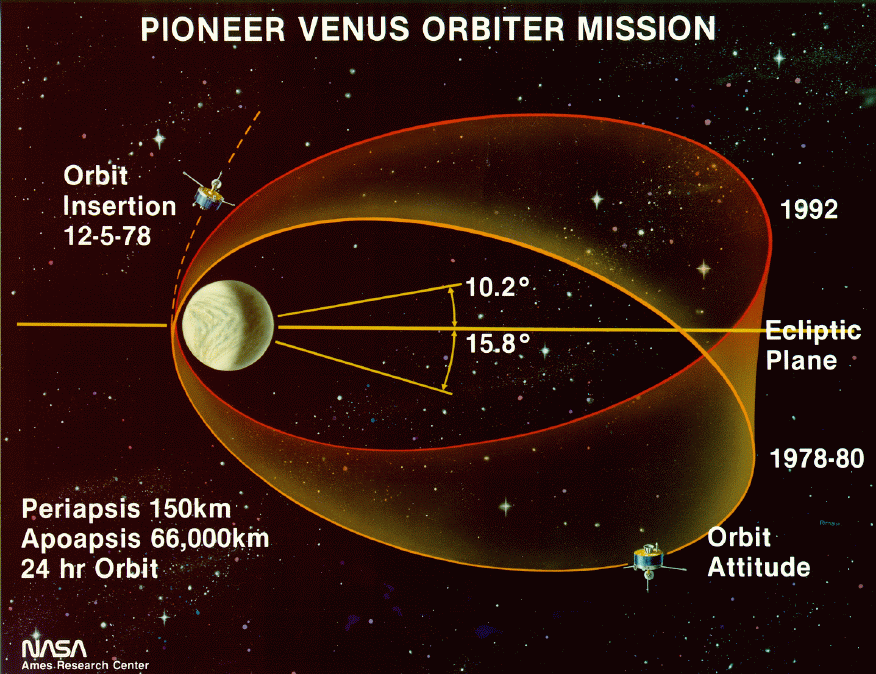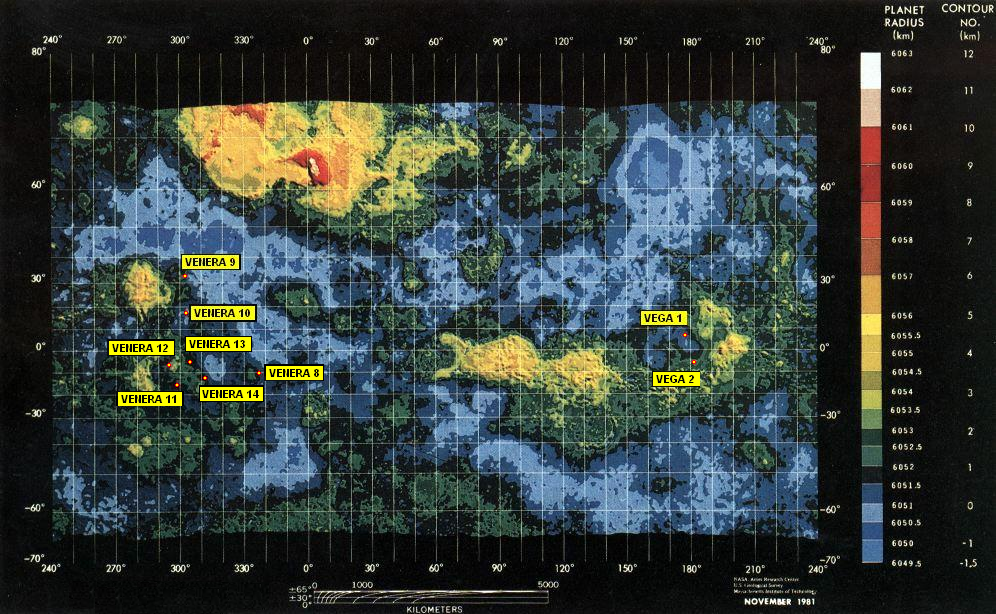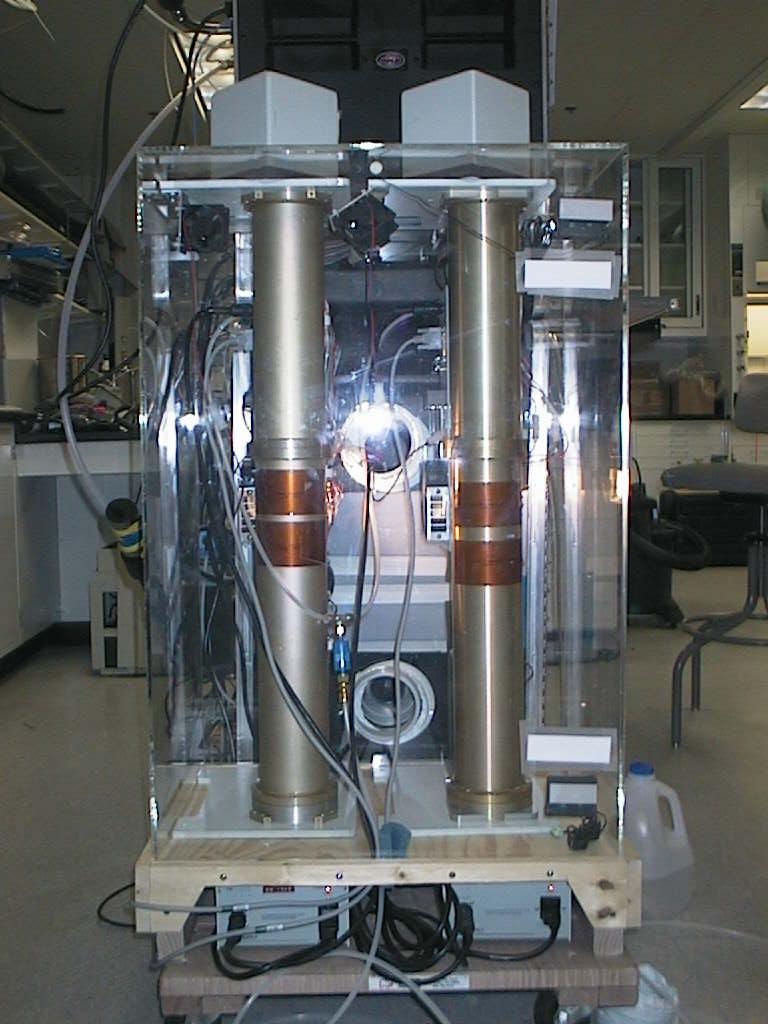|
Pioneer Venus
The Pioneer Venus project was part of the Pioneer program consisting of two spacecraft, the Pioneer Venus Orbiter and the Pioneer Venus Multiprobe, launched to Venus in 1978. The program was managed by NASA's Ames Research Center. The Pioneer Venus Orbiter entered orbit around Venus on December 4, 1978, and performed observations to characterize the atmosphere and surface of Venus. It continued to transmit data until October 1992. The Pioneer Venus Multiprobe deployed four small probes into the Venusian atmosphere on December 9, 1978. All four probes transmitted data throughout their descent to the surface. One probe survived the landing and transmitted data from the surface for over an hour. Overview The Pioneer mission consisted of two components, launched separately: an orbiter and a multiprobe. Orbiter The orbiter was launched on May 20, 1978 on an Atlas-Centaur rocket. The orbiter's mass was . The Pioneer Venus Orbiter was inserted into an elliptical orbit around Ve ... [...More Info...] [...Related Items...] OR: [Wikipedia] [Google] [Baidu] |
Pioneer Venus Orbiter
The Pioneer Venus Orbiter, also known as Pioneer Venus 1 or Pioneer 12, was a mission to Venus conducted by the United States as part of the Pioneer Venus project. Launched in May 1978 atop an Atlas-Centaur rocket, the spacecraft was inserted into an elliptical orbit around Venus on December 4, 1978. It returned data on Venus until October 1992. Launch and arrival at Venus The Pioneer Venus Orbiter was launched by an Atlas SLV-3D Centaur-D1AR rocket, which flew from Launch Complex 36A at the Cape Canaveral Air Force Station. The launch occurred at 13:13:00 on May 20, 1978, and deployed the Orbiter into heliocentric orbit for its coast to Venus. Venus orbit insertion occurred on December 4, 1978. Spacecraft Manufactured by Hughes Aircraft Company, the Pioneer Venus Orbiter was based on the HS-507 bus. The spacecraft was a flat cylinder, in diameter and long. All instruments and spacecraft subsystems were mounted on the forward end of the cylinder, except the magnetometer, whi ... [...More Info...] [...Related Items...] OR: [Wikipedia] [Google] [Baidu] |
Pioneer Venus Multiprobe
The Pioneer Venus Multiprobe, also known as Pioneer Venus 2 or Pioneer 13, was a spacecraft launched in 1978 to explore Venus as part of NASA's Pioneer program. This part of the mission included a spacecraft bus which was launched from Earth carrying one large and three smaller probes, which after separating penetrated the Venusian atmosphere at a different location, returning data as they descended into the planet's thick atmosphere. The entry occurred on December 9, 1978. In context There was also an orbiter launched in 1978, part of the overall Pioneer Venus project along with this entry probe mission. Whereas the probes entered the atmosphere in 1978, the orbiter would stay in orbit throughout the 1980s and the early 1990s (see Pioneer Venus Orbiter). The next major mission was the Magellan spacecraft, which was an orbiter capable of mapping Venus by seeing through its opaque clouds with radar. Another NASA entry probe mission was the Galileo probe, which was for planet Jupi ... [...More Info...] [...Related Items...] OR: [Wikipedia] [Google] [Baidu] |
Mass Spectrometer
Mass spectrometry (MS) is an analytical technique that is used to measure the mass-to-charge ratio of ions. The results are presented as a ''mass spectrum'', a plot of intensity as a function of the mass-to-charge ratio. Mass spectrometry is used in many different fields and is applied to pure samples as well as complex mixtures. A mass spectrum is a type of plot of the ion signal as a function of the mass-to-charge ratio. These spectra are used to determine the elemental or isotopic signature of a sample, the masses of particles and of molecules, and to elucidate the chemical identity or structure of molecules and other chemical compounds. In a typical MS procedure, a sample, which may be solid, liquid, or gaseous, is ionized, for example by bombarding it with a beam of electrons. This may cause some of the sample's molecules to break up into positively charged fragments or simply become positively charged without fragmenting. These ions (fragments) are then separated according ... [...More Info...] [...Related Items...] OR: [Wikipedia] [Google] [Baidu] |
Venera
The Venera (, , which means "Venus" in Russian) program was the name given to a series of space probes developed by the Soviet Union between 1961 and 1984 to gather information about the planet Venus. Ten probes successfully landed on the surface of the planet, including the two Vega program and Venera-Halley probes, while thirteen probes successfully entered the Venusian atmosphere. Due to the extreme surface conditions on Venus, the probes could only survive for a short period on the surface, with times ranging from 23 minutes to two hours. The ''Venera'' program established a number of precedents in space exploration, among them being the first human-made devices to enter the atmosphere of another planet (Venera 3 on 1 March 1966), the first to make a soft landing on another planet (Venera 7 on 15 December 1970), the first to return images from another planet's surface (Venera 9 on 8 June 1975), the first to record sounds on another planet (Venera 13 on 30 October 1981) ... [...More Info...] [...Related Items...] OR: [Wikipedia] [Google] [Baidu] |
Vega Program
The Vega program (Cyrillic: ВеГа) was a series of Venus missions that also took advantage of the appearance of comet 1P/Halley in 1986. ''Vega 1'' and ''Vega 2'' were uncrewed spacecraft launched in a cooperative effort among the Soviet Union (who also provided the spacecraft and launch vehicle) and Austria, Bulgaria, France, Hungary, the German Democratic Republic, Poland, Czechoslovakia, and the Federal Republic of Germany in December 1984. They had a two-part mission to investigate Venus and also flyby Halley's Comet. The flyby of Halley's Comet had been a late mission change in the Venera program following on from the cancellation of the American Halley mission in 1981. A later Venera mission was canceled and the Venus part of the ''Vega 1'' mission was reduced. Because of this, the craft was designated VeGa, a contraction of ''Venera'' and ''Gallei'' (Венера and Галлей respectively, the Russian words for "Venus" and "Halley"). The spacecraft design was bas ... [...More Info...] [...Related Items...] OR: [Wikipedia] [Google] [Baidu] |
1978 In Spaceflight
1978 saw the launch of the Pioneer Venus missions launched by the United States, on 20 May and 8 August. The Pioneer Venus Multiprobe landed four spacecraft on the planet, one of which transmitted data for 67 minutes before being destroyed by atmospheric pressure. ISEE-C, which was launched on 8 December, flew past comet 21P/Giacobini–Zinner in 1985, and Halley's Comet Halley's Comet or Comet Halley, officially designated 1P/Halley, is a short-period comet visible from Earth every 75–79 years. Halley is the only known short-period comet that is regularly visible to the naked eye from Earth, and thus the o ... in 1986.Hughes, J (1996) Larousse Desk Reference Encloypedia London RD Press Launches Deep Space Rendezvous EVAs References Footnotes {{Orbital launches in 1978 Spaceflight by year ... [...More Info...] [...Related Items...] OR: [Wikipedia] [Google] [Baidu] |
Nephelometer
A nephelometer or aerosol photometer is an instrument for measuring the concentration of suspended particulates in a liquid or gas colloid. A nephelometer measures suspended particulates by employing a light beam (source beam) and a light detector set to one side (often 90°) of the source beam. Particle density is then a function of the light reflected into the detector from the particles. To some extent, how much light reflects for a given density of particles is dependent upon properties of the particles such as their shape, color, and reflectivity. Nephelometers are calibrated to a known particulate, then use environmental factors (k-factors) to compensate lighter or darker colored dusts accordingly. K-factor is determined by the user by running the nephelometer next to an air sampling pump and comparing results. There are a wide variety of research-grade nephelometers on the market as well as open source varieties. Nephelometer uses The main uses of nephelometers rela ... [...More Info...] [...Related Items...] OR: [Wikipedia] [Google] [Baidu] |
Radiant Flux
In radiometry, radiant flux or radiant power is the radiant energy emitted, reflected, transmitted, or received per unit time, and spectral flux or spectral power is the radiant flux per unit frequency or wavelength, depending on whether the Spectral radiometric quantity, spectrum is taken as a function of frequency or of wavelength. The International System of Units, SI unit of radiant flux is the watt (W), one joule per second (), while that of spectral flux in frequency is the watt per hertz () and that of spectral flux in wavelength is the watt per metre ()—commonly the watt per nanometre (). Mathematical definitions Radiant flux Radiant flux, denoted Φe ('e' for "energetic", to avoid confusion with Photometry (optics), photometric quantities), is defined as \Phi_\mathrm = \frac :Q_\mathrm = \int_ \mathbf\cdot \hat\mathbf\, dA where *''t'' is the time; *''Q''e is the radiant energy flux of the Electromagnetic field, field out of a closed surface \Sigma; *S is the Poynting ... [...More Info...] [...Related Items...] OR: [Wikipedia] [Google] [Baidu] |
Gas Chromatograph
Gas chromatography (GC) is a common type of chromatography used in analytical chemistry for separating and analyzing compounds that can be vaporized without decomposition. Typical uses of GC include testing the purity of a particular substance, or separating the different components of a mixture. In preparative chromatography, GC can be used to prepare pure compounds from a mixture. Gas chromatography is also sometimes known as vapor-phase chromatography (VPC), or gas–liquid partition chromatography (GLPC). These alternative names, as well as their respective abbreviations, are frequently used in scientific literature. Gas chromatography is the process of separating compounds in a mixture by injecting a gaseous or liquid sample into a mobile phase, typically called the carrier gas, and passing the gas through a stationary phase. The mobile phase is usually an inert gas or an unreactive gas such as helium, argon, nitrogen or hydrogen. The stationary phase is a microscopic la ... [...More Info...] [...Related Items...] OR: [Wikipedia] [Google] [Baidu] |
Satellite Bus
A satellite bus (or spacecraft bus) is the main body and structural component of a satellite or spacecraft, in which the payload and all scientific instruments are held. Bus-derived satellites are opposed to specially produced satellites. Bus-derived satellites are usually customized to customer requirements, for example with specialized sensors or transponders, in order to achieve a specific mission. They are commonly used for geosynchronous satellites, particularly communications satellites, but are also used in spacecraft which occupy lower orbits, occasionally including low Earth orbit missions. Examples Some satellite bus examples include: * Boeing DS&S 702 * Lockheed Martin Space Systems A2100 * Alphabus * INVAP ARSAT-3K * Airbus D&S Eurostar * ISRO's I-1K, I-2K, I-3K, I-4K, I-6K, and Indian Mini Satellite bus * NASA Ames MCSB * SSL 1300 * Orbital ATK GEOStar * Mitsubishi Electric DS2000 * Spacecraft bus of the James Webb Space Telescope * SPUTNIX TabletSat * ... [...More Info...] [...Related Items...] OR: [Wikipedia] [Google] [Baidu] |
Gamma-ray Burst
In gamma-ray astronomy, gamma-ray bursts (GRBs) are immensely energetic explosions that have been observed in distant galaxies. They are the most energetic and luminous electromagnetic events since the Big Bang. Bursts can last from ten milliseconds to several hours. After an initial flash of gamma rays, a longer-lived "afterglow" is usually emitted at longer wavelengths (X-ray, ultraviolet, optical, infrared, microwave and radio). The intense radiation of most observed GRBs is thought to be released during a supernova or superluminous supernova as a high-mass star implodes to form a neutron star or a black hole. A subclass of GRBs appear to originate from the merger of binary neutron stars. The sources of most GRBs are billions of light years away from Earth, implying that the explosions are both extremely energetic (a typical burst releases as much energy in a few seconds as the Sun will in its entire 10-billion-year lifetime) and extremely rare (a few per galaxy per milli ... [...More Info...] [...Related Items...] OR: [Wikipedia] [Google] [Baidu] |



.jpg)




